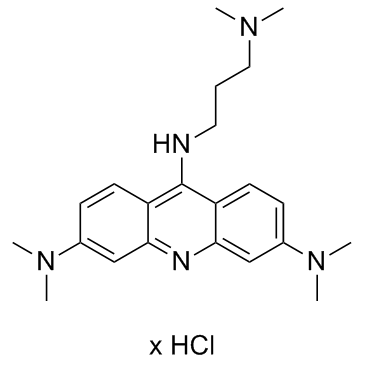3,6-DMAD hydrochloride |
| Catalog No.GC34384 |
El clorhidrato de 3,6-DMAD, un derivado de la acridina, es un potente inhibidor de la vÍa IRE1α-XBP1s. El clorhidrato de 3,6-DMAD promueve la secreciÓn de IL-6 a través de la vÍa IRE1α-XBP1s. El clorhidrato de 3,6-DMAD inhibe la oligomerizaciÓn de IRE1α y la actividad de la endorribonucleasa (RNasa). El clorhidrato de 3,6-DMAD se puede utilizar para la investigaciÓn del cÁncer.
Products are for research use only. Not for human use. We do not sell to patients.

Sample solution is provided at 25 µL, 10mM.
3,6-DMAD hydrochloride is a inhibitor of the IRE1α-XBP1 pathway of the unfolded protein response.
3,6-DMAD inhibits both IRE1α oligomerization and in vitro endoribonuclease (RNase) activity[1].
Following three intraperitoneal administrations of 3,6-DMAD at a dose of 10 mg/kg every 12 hours, 3,6-DMAD significantly inhibits in vivo XBP1-luciferase activity assessed 3.5 days after the initial treatment. 3,6-DMAD-treatment significantly inhibits tumor xenograft growth[1].
[1]. Jiang D, et al. Acridine Derivatives as Inhibitors of the IRE1α-XBP1 Pathway Are Cytotoxic to Human Multiple Myeloma. Mol Cancer Ther. 2016 Sep;15(9):2055-65.
Average Rating: 5 (Based on Reviews and 40 reference(s) in Google Scholar.)
GLPBIO products are for RESEARCH USE ONLY. Please make sure your review or question is research based.
Required fields are marked with *




















